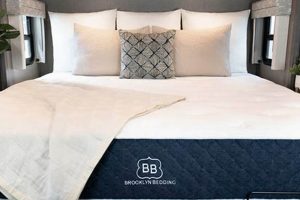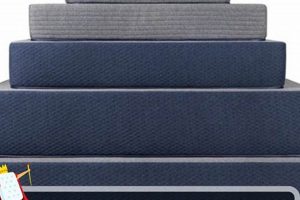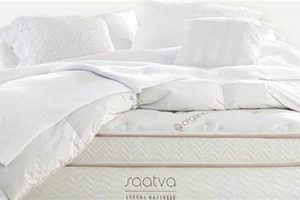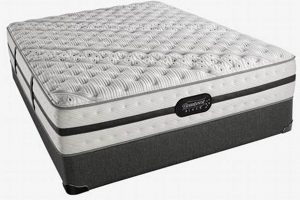The selection of an appropriate sleeping surface significantly impacts sleep quality, especially when shared by two individuals. A large mattress size, specifically designed to accommodate dual sleepers, addresses concerns such as motion transfer and individual space, thereby potentially enhancing restorative rest.
Optimal sleep contributes to improved physical and cognitive function. Furthermore, a reduction in sleep disturbances for partnered individuals can lead to enhanced relationship satisfaction. Historically, mattress sizes were less standardized, leading to variability in sleep comfort; the king size emerged as a standard offering greater personal space.
Therefore, an exploration of factors such as mattress type, materials, and construction techniques becomes essential when assessing options designed to provide a supportive and undisturbed night’s sleep for two individuals. Key considerations include motion isolation, edge support, and temperature regulation.
Selecting a Suitable Large Mattress for Two Individuals
The purchase of a large sleeping surface for dual occupancy requires careful evaluation of specific product features to ensure optimal sleep quality and minimize disturbances.
Tip 1: Prioritize Motion Isolation: Mattresses with excellent motion isolation prevent movement on one side from disrupting the other sleeper. Foam or individually wrapped coil constructions are typically effective in this regard.
Tip 2: Evaluate Edge Support: Strong edge support maximizes the usable sleeping surface and prevents roll-off, particularly important when sharing a large mattress. Reinforced edges provide greater stability and comfort.
Tip 3: Consider Temperature Regulation: Temperature regulation is crucial for comfortable sleep. Mattresses incorporating breathable materials, such as open-cell foam or hybrid designs, can help dissipate heat and maintain a neutral sleeping temperature.
Tip 4: Assess Firmness Level: Firmness preference is subjective, but a medium-firm mattress often accommodates a wider range of sleep positions and body types. Consider a split firmness option if individual preferences differ significantly.
Tip 5: Research Mattress Materials: Mattress materials, such as latex, memory foam, or innerspring coils, each offer distinct performance characteristics. Research the pros and cons of each material to determine the best fit.
Tip 6: Verify Certifications: Certifications such as CertiPUR-US or OEKO-TEX indicate that the mattress has been tested for harmful substances and meets specific safety and environmental standards.
Tip 7: Review Trial Periods and Warranties: A generous trial period allows for sufficient time to assess mattress comfort and performance. A comprehensive warranty protects against manufacturing defects and premature wear.
Careful consideration of these factors allows for a more informed decision-making process, ultimately leading to a sleeping solution that meets the needs of both individuals and promotes restful sleep.
The following sections will delve into specific mattress types and their suitability for partnered individuals, providing a comparative analysis of available options.
1. Motion Isolation
Motion isolation, a critical attribute of a suitable sleep surface for dual occupancy, directly correlates with sleep quality, particularly when considering a large mattress. The primary function of motion isolation is to minimize the transfer of movement from one area of the mattress to another. This characteristic is paramount in preventing disturbances caused by a partner’s tossing, turning, or getting in and out of bed. The effectiveness of motion isolation is determined by the mattress’s internal construction and materials. Mattresses constructed with individually wrapped coils or dense foam layers excel in absorbing and dissipating movement, thus significantly reducing the likelihood of one sleeper affecting the other. A king mattress’s inherent size provides more surface area, potentially mitigating some motion transfer; however, the materials and construction remain the decisive factors.
The absence of adequate motion isolation can lead to fragmented sleep, decreased sleep duration, and increased irritability. Consider a scenario where one partner frequently changes positions during the night. Without effective motion isolation, each movement transmits across the mattress, potentially waking the other partner. Over time, this chronic sleep disruption can contribute to a range of health problems, including impaired cognitive function and weakened immune response. Conversely, a mattress with superior motion isolation allows both partners to experience undisturbed sleep, fostering a more restful and restorative sleep cycle. This directly translates into improved daytime alertness and overall well-being for both individuals.
In conclusion, motion isolation is a fundamental requirement for any king-sized mattress intended for partnered sleep. Understanding the mechanisms and benefits of motion isolation enables consumers to make informed decisions, ultimately leading to a sleeping solution that promotes individual and shared sleep quality. Failure to prioritize this aspect may result in recurring sleep disturbances and negatively impact the overall health and relationship dynamics of the individuals sharing the bed.
2. Edge Support
Edge support, a crucial attribute in a sleep surface designed for two individuals, directly impacts usable surface area and overall stability, particularly in a king-sized mattress. Inadequate edge support results in a feeling of instability near the perimeter, compressing excessively under pressure and creating a sensation of rolling off. This issue becomes amplified when two individuals share the mattress, as the available sleeping space is effectively reduced. Enhanced edge support, conversely, ensures consistent comfort and support across the entire mattress, maximizing the usable surface area and preventing the discomfort associated with sleeping near the edge. The causal relationship is clear: diminished edge support limits the effective sleep surface, while robust edge support enhances both comfort and the practical dimensions of the sleeping area.
Consider a scenario where one individual frequently sleeps near the edge of the mattress. Without adequate edge support, that individual may experience a sensation of instability and a tendency to roll off, leading to disrupted sleep. Furthermore, getting in and out of bed becomes more challenging. Conversely, a king mattress with reinforced edges provides a stable and supportive perimeter, facilitating ease of movement and maximizing usable space. This is particularly relevant for individuals who share the bed with children or pets, as the available space may become further constrained. Practical implications include enhanced co
mfort, improved sleep quality, and a reduction in the likelihood of accidental falls or injuries, especially for elderly individuals.
In summary, edge support is a critical component in determining the suitability of a king mattress for partnered sleep. Its significance lies in maximizing the usable surface area, preventing feelings of instability, and ensuring comfortable movement in and out of bed. The enhanced stability it provides contributes to overall sleep quality and reduces the risk of injury. Prioritizing edge support is essential for optimizing the shared sleep experience, thereby underscoring its integral role in evaluating a king mattress intended for dual occupancy.
3. Temperature Regulation
Temperature regulation within a sleep environment directly influences sleep quality, especially when considering a shared sleep surface. A king mattress, designed for dual occupancy, presents unique challenges in maintaining a comfortable thermal environment for both individuals. Efficient temperature regulation minimizes sleep disturbances caused by overheating or excessive cooling, contributing to a more restful and restorative sleep cycle.
- Material Breathability
Mattress materials play a crucial role in heat dissipation. Open-cell foam, latex, and innerspring constructions promote airflow, preventing heat build-up. For instance, a traditional memory foam mattress, known for conforming to the body, can trap heat. Alternatively, memory foam infused with gel or copper particles aims to mitigate this effect. The breathability of the materials directly affects the microclimate within the sleeping surface, impacting comfort levels for both sleepers.
- Moisture Wicking Fabrics
Mattress covers made from moisture-wicking fabrics such as Tencel or bamboo can help regulate temperature by drawing moisture away from the body. This is particularly beneficial for individuals who tend to perspire during sleep. A mattress cover that lacks moisture-wicking properties can create a damp and uncomfortable sleep environment, disrupting sleep patterns for one or both partners.
- Construction Design
The structural design of a mattress influences airflow and heat transfer. Hybrid mattresses, combining innerspring coils with foam layers, often exhibit better temperature regulation compared to all-foam models due to the increased airflow within the coil system. Similarly, mattresses with strategically placed ventilation channels can enhance heat dissipation. The configuration of these internal components plays a significant role in maintaining a stable sleep temperature.
- Individual Thermal Preferences
Differing thermal preferences between partners pose a significant challenge in optimizing sleep comfort. Solutions include mattresses with dual-zone temperature control, allowing each individual to adjust their side of the bed independently. Alternatively, using separate blankets or a mattress topper with cooling properties can address individual needs without compromising the comfort of the other partner. Acknowledging and accommodating these individual preferences is critical for ensuring a satisfactory shared sleep experience.
Ultimately, effective temperature regulation is a pivotal factor in selecting a suitable king mattress for couples. By carefully considering material breathability, moisture-wicking properties, construction design, and individual thermal preferences, consumers can mitigate sleep disturbances caused by temperature fluctuations and promote a more restful and harmonious sleep environment. The optimization of this aspect contributes substantially to the overall satisfaction and well-being of partnered individuals.
4. Firmness Preferences
The selection of an appropriate mattress firmness level is a critical determinant of sleep quality, particularly when evaluating options for partnered individuals seeking a king-sized sleep surface. The interplay between individual comfort preferences and shared sleep space necessitates a careful consideration of firmness characteristics to minimize sleep disturbances and promote overall satisfaction. Discrepancies in preferred firmness can lead to compromised spinal alignment, pressure point discomfort, and subsequent disruptions in sleep architecture. A mattress deemed too soft may fail to provide adequate support for one partner, while a mattress considered too firm may induce pressure point pain for the other. The optimal solution involves a nuanced approach that balances individual requirements with the constraints of a shared sleep environment. The effectiveness of a large mattress for partnered sleep is directly contingent on addressing and accommodating divergent firmness preferences.
Several strategies can mitigate the challenges associated with differing firmness requirements. One approach involves selecting a mattress with a medium-firm construction, often regarded as a compromise that accommodates a broader range of sleep positions and body types. Alternatively, mattresses with customizable firmness levels on each side provide a tailored solution, allowing each individual to adjust the support to their specific needs. The practical application of understanding these nuances can significantly impact relationship dynamics. Chronic sleep deprivation resulting from an unsuitable mattress can lead to irritability and decreased overall well-being, whereas a thoughtfully chosen mattress that addresses individual firmness preferences can foster a more harmonious shared sleep experience. Moreover, knowledge of firmness scales, ranging from extra-soft to extra-firm, allows for informed comparisons across different mattress brands and models.
In summary, the acknowledgment and accommodation of varying firmness preferences are essential components of selecting a suitable king mattress for partnered sleep. Failure to address this critical aspect may result in compromised sleep quality and dissatisfaction for one or both individuals. By considering factors such as sleeping position, body weight, and individual comfort requirements, and by exploring options such as medium-firm mattresses or those with adjustable firmness zones, consumers can increase the likelihood of selecting a sleep surface that promotes restful and restorative sleep for both partners, therefore the mattress becomes “Best king mattress for couples”. The benefits of this approach extend beyond individual comfort, contributing to improved relationship satisfaction and overall well-being.
5. Material Durability
Material durability is a fundamental consideration in evaluating a sleep surface intended for dual occupancy. The longevity and continued performance of a king mattress are directly linked to the quality and resilience of its constituent materials. A durable mattress maintains its supportive properties and comfort level over an extended period, providing consistent sleep quality for both individuals.
- Foam Density and Resilience
Foam density, particularly in memory foam and latex layers, significantly influences mattress durability. Higher density foams exhibit greater resistance to compression and deformati
on, retaining their shape and supportiveness for longer. For example, a memory foam mattress with a density of 4 pounds per cubic foot will generally outlast one with a density of 2 pounds per cubic foot. In the context of a shared mattress, durable foams prevent the formation of body impressions and sagging, ensuring consistent support across the entire sleep surface. - Coil Gauge and Count
In innerspring and hybrid mattresses, the gauge and count of the coils directly correlate with durability. Lower gauge coils (thicker wires) offer greater support and resistance to wear. Higher coil counts distribute weight more evenly, reducing stress on individual coils and prolonging mattress life. For instance, a king mattress with 800 individually pocketed coils of 13-gauge steel will typically offer superior durability compared to one with 600 coils of 15-gauge steel. This is crucial for couples as it ensures even weight distribution and prevents premature sagging or unevenness.
- Fabric Strength and Stitching
The strength and quality of the mattress fabric and stitching contribute significantly to overall durability. High-quality fabrics, such as tightly woven cotton or reinforced polyester blends, resist tearing, stretching, and abrasion. Robust stitching prevents seams from unraveling, maintaining the structural integrity of the mattress over time. For example, a mattress with double-stitched seams and a high thread count fabric will be more resistant to wear and tear, particularly along the edges where stress is concentrated.
- Foundation Compatibility
The type of foundation used beneath the mattress also affects its durability. A supportive and compatible foundation prevents sagging and uneven wear. For example, using a solid platform foundation or a box spring designed to support the weight of a king mattress and two adults will help maintain the mattress’s shape and prolong its lifespan. Conversely, an inadequate or sagging foundation can accelerate wear and tear, compromising the mattress’s structural integrity.
In conclusion, material durability is paramount when selecting a king mattress intended for shared occupancy. Factors such as foam density, coil gauge and count, fabric strength, and foundation compatibility collectively determine the mattress’s longevity and continued performance. A focus on these aspects ensures that the chosen sleeping surface maintains its supportiveness, comfort, and structural integrity, providing consistent sleep quality for both individuals and ultimately contributing to its status as a leading option.
6. Spinal Alignment
Spinal alignment represents a critical biomechanical consideration when selecting a shared sleep surface, particularly a king mattress intended for dual occupancy. Proper spinal alignment during sleep minimizes stress on vertebral structures, supporting muscles, and associated ligaments. Conversely, inadequate support leading to spinal misalignment contributes to back pain, muscle stiffness, and compromised sleep quality. Therefore, a mattress promoting optimal spinal alignment directly influences the restorative nature of sleep, a factor of paramount importance when shared by two individuals. A king mattress, due to its size, must adequately support varying body types and sleeping positions to facilitate proper spinal alignment for both occupants. The selection of a mattress failing to meet these requirements may exacerbate existing spinal issues or create new discomfort, negatively impacting sleep patterns and overall well-being.
The relationship between mattress construction and spinal alignment is causal and multifaceted. A mattress offering insufficient support allows the heavier parts of the body, such as the hips and shoulders, to sink excessively, leading to spinal curvature. Conversely, a mattress that is too firm may not conform to the natural contours of the body, creating pressure points and preventing proper spinal alignment. For instance, a side sleeper requires a mattress that allows the shoulder and hip to sink slightly, maintaining a neutral spine, whereas a back sleeper needs adequate lumbar support to prevent excessive arching. The best king mattress for couples will address these differing needs, ideally through a combination of supportive core materials and pressure-relieving comfort layers. Consider a scenario where one partner requires a firmer mattress due to back issues, while the other prefers a softer surface. A mattress with zoned support, offering differential firmness levels across its surface, could provide a practical solution, ensuring optimal spinal alignment for both individuals without compromising comfort. Practical significance translates to reduced back pain, improved sleep quality, and enhanced daytime function for partnered individuals.
In summary, spinal alignment is an indispensable element in evaluating the suitability of a king mattress for couples. Its importance stems from the direct correlation between proper spinal support and restorative sleep. The challenges associated with achieving optimal spinal alignment for two individuals with potentially differing needs can be addressed through a careful selection of mattress type, construction, and features such as zoned support. The understanding of this biomechanical principle allows for more informed consumer decisions, leading to a sleeping surface that promotes both individual and shared sleep quality. Therefore, spinal alignment, while often overlooked, is a cornerstone criterion when identifying a leading option for partnered sleep.
Frequently Asked Questions
The following section addresses common inquiries regarding the selection and suitability of a king-size mattress for partnered sleep, providing evidence-based information to guide informed decision-making.
Question 1: Is a king mattress always the best choice for couples?
While a king mattress offers ample space for two individuals, its suitability depends on bedroom size, budget constraints, and individual sleep preferences. Alternative options, such as a queen mattress with enhanced motion isolation, may suffice for certain couples.
Question 2: How does mattress type impact sleep quality for couples?
Mattress type significantly affects sleep quality. Memory foam excels in motion isolation, while innerspring mattresses offer superior airflow. Hybrid models combine these benefits. The selection should align with individual needs and preferences.
Question 3: What level of firmness is most appropriate for a shared king mattress?
A medium-firm mattress typically accommodates a wider range of sleeping positions and body types, providing a balanced combination of support and comfort. Split-firmness options cater to differing individual requirements.
Question 4: How important is edge support in a king mattress for couples?
Edge support is crucial for maximizing usable sleeping space and preventing roll-off, particularly for individuals who sleep near the perimeter. Reinforced edges enhance stability and comfort, crucial for safety.
Question 5: Can a mattress topper compensate for an unsuitable king mattress?
A mattress topper can enhance comfort and address specific issues such as excessive firmness or lack of pressure relief. However, it cannot fully compensate for fundamental flaws in mattress support or construction.
Question 6: How often should a king mattress be replaced?
The lifespan of a king mattress varies depending o
n material quality and usage. Generally, replacement is recommended every 7-10 years or when signs of sagging, body impressions, or decreased support become evident.
In conclusion, selecting a king mattress for partnered sleep requires careful consideration of individual needs, mattress characteristics, and practical constraints. Informed decision-making leads to enhanced sleep quality and overall well-being.
The subsequent sections will delve into specific product recommendations and comparative analyses, providing further guidance for optimal mattress selection.
Selecting the Best King Mattress for Couples
The preceding analysis has explored the multifaceted considerations essential for selecting a large mattress appropriate for shared sleep. The optimal sleeping surface minimizes motion transfer, provides consistent edge support, regulates temperature effectively, accommodates varying firmness preferences, exhibits material durability, and promotes proper spinal alignment. Addressing each of these parameters is crucial for maximizing sleep quality and mitigating potential disturbances.
The pursuit of a superior sleeping solution for partnered individuals represents an investment in long-term health and relationship well-being. Continued research and technological advancements in mattress design are expected to further refine the options available, leading to increasingly personalized and optimized sleep experiences. Therefore, a commitment to informed decision-making remains paramount in achieving a truly restorative sleep environment.



![Top Rated Best Wyoming King Mattress [Review] Organic & Natural Mattress Buyer’s Guide: Non-Toxic Sleep Solutions Top Rated Best Wyoming King Mattress [Review] | Organic & Natural Mattress Buyer’s Guide: Non-Toxic Sleep Solutions](https://mattressworldpa.com/wp-content/uploads/2025/07/th-7657-300x200.jpg)



